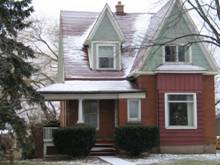Palermo/Hagarstown Timeline
- 1806 First Settlers
- 1808 William Case Methodist Circuit rider preached in Palermo
- 1812 First Methodist meetings at Lawrence Hagar’s home
- 1818 Land purchased for a cemetery by the Methodist congregation and could also be used for a meeting house and schoolhouse should they be required.
- 1824 Palermo Chapel built
- 1835 Post office established & town named Palermo
- 1836 Methodist Church court case regarding divisions in the church ended a 3 year battle with all property going to Wesleyan Methodist & not Methodist Episcopal Church. This lead to the Episcopalians building their own building on the other side of the Palermo Cemetery which became very successful and they later built present sanctuary of Palermo United Church (land records show 54×110 feet given to church on NE corner in 1871 by Lucinda & Ezra Winchell and 1/2 acre given by William Laidlaw & wife in 1875)
- 1844 First Palermo schoolhouse built (1876 William Hagar gave 3/4 acre for $30)
- 1955 TC Usher Plastic Processing plant destroyed by Fire
- Had a private Grammer School and a town hall that was demolished in 1960’s. The Region Museum has artifacts from the hall
Historical Buildings
2460 Bronte Rd. Con. 1 SDS Lot 31
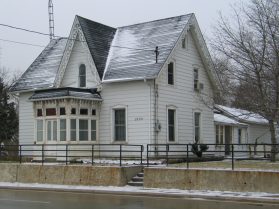
3017 Bronte Rd. Con. 1 NDS Lot 30 (Former Church Parsonage)
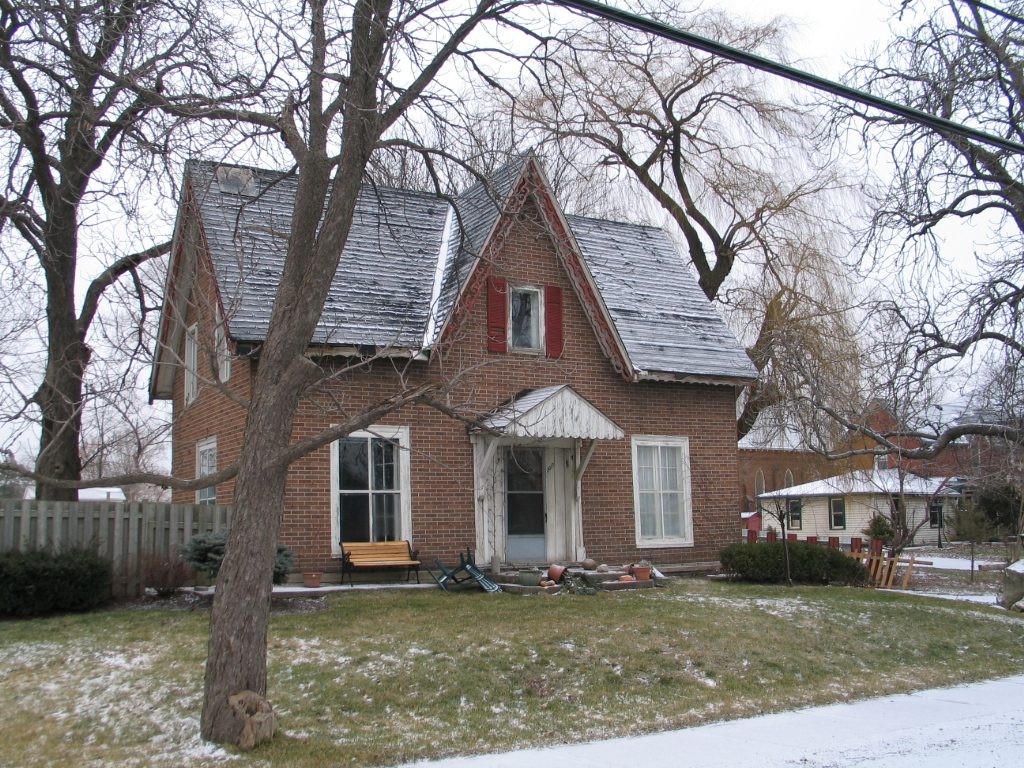
2431 Dundas Street West (Palermo School House)
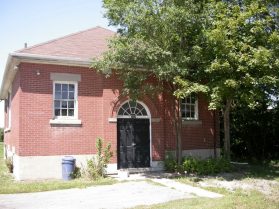
This former Trafalgar Township schoolhouse S.S.#2 has undergone restoration to be a working schoolhouse museum and home to the Historical Society’s archives. The school house existed in 1817 as one of only 3 schoolhouses in the Township, although it may not have been on the existing property. Palermo school was one of the first in the Province to offer music instruction as a regular part of the curriculum, thanks to funding from a local Palermo Women’s group. A school house was built in this location in 1844 and again in 1875. The school built in 1875, was a two room schoolhouse with a center hall entrance. It was damaged by a storm in the early 1940’s and many of the materials were reused when the present school was built in 1942. The cornerstone from the 1875 schoolhouse was incorporated into the back of the 1942 building. At the time the school closed in the early 1960’s, it was one of 18 schools in the Township. When the old schoolhouse closed, the children were moved to the new much larger modern Palermo school that is now part of the Catholic school on the East side of Bronte Rd just below Dundas St. At the time of the closure, the youngest grades were taught at the Palermo Hall while the older children were taught in the old Schoolhouse. The old schoolhouse was then the home of the Trafalgar Police Department, followed by the Town of Oakville Planning Department and finally the Oakville Players.
2527 Dundas Street West, Palermo
3015 Dundas Street West, Palermo
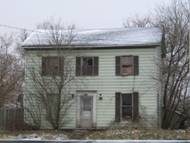
- 1806 Wilmot Survey David Hagar
- 1809 Land sold to Laurence Hagar b. 1784 d. 1870 son of David (he may have lived on the land before this time.
- Legend is that Lawrence Hagar who founded Hagerstown which later became Palermo was the first Euro- Canadian white settler in Trafalgar twp. He came from Pennsylvania to Upper Canada in 1799 and first settled at Forty Mile Creek before moving to Second Line & Dundas Street. Converted at a camp meeting in Clinton Township in 1807, he is said to have written in a diary: “Deeply impressed with a sense of duty to God, [I] at once erected a family altar which has never been thrown down.” (2) This commitment, shared by his wife, Suzanna Teetzel, whom he married in 1808, brought about the first gathering for worship in in the Hager home in 1812. The records of Ryan’s Canadian Wesleyan Methodist Church reveal that in 1835 Laurence Hager was appointed to serve as a local preacher in the Humber and Trafalgar Circuit. His career as a preacher may not have lasted very long, but Hager’s powerful personality had considerable local influence well into his later years. He built the first store in the community in 1830, sold it in 1835, and the following year opened a hotel. His younger brother David opened another hotel across the street in 1840. As well as engaging in these prosperous business ventures, he returned to the Methodist Episcopal fold. There is a fascinating local legend about him during his declining years. In 1850, the Wesleyans built another chapel on the east side of the same half-acre cemetery where the Methodist Episcopal chapel stood. For the next twenty years the two chapels competed for the souls of the residents of what was then a prosperous village with all the accoutrements of a rural life centre. There were wooden sidewalks, two taverns (both operated by the Hagers), a temperance hall, a public school, a chair factory and a farm machinery manufacturer. Eschewing the rivalry within the Methodist family, the Anglicans built their own church at the west end of the village. Legend has it that uncomfortable church seating caused Laurence Hager to bring his own chair to the chapel. Poor hearing caused him to place his chair close to the pulpit. He frequently disagreed with the preacher’s sermons. Whenever that happened, he would pick up his chair, stomp out of the chapel and make an angry pilgrimage across the cemetery to the other chapel. There he would remain until a new preacher arrived. Or, when the other preacher also displeased him, he would stormily retrace his steps across the cemetery. For all his irascibility, Laurence Hager was not an ungenerous man. An 1851 report of the dedication of the Wesleyan chapel in the Christian Guardian records that the assembled congregation was too large for the small building. Hager and other leaders of the Methodist Episcopal chapel offered their premises for the overflow congregation. Two simultaneous services were held, one hearing the guest preacher, Rev. E. Wood, the other ministered to by the local Wesleyan minister, Rev. John Gemley. (4)(Information from Rev. John Sherman)
- 1851 census Lawrence Hagar in frame house
- 1858 Tremaine Map Jonathon Hagar (son of Lawrence)
- 1861 Trafalgar census Lawrence listed as farmer
- 1877 Historical Atlas Jonathon Hagar
- Town records list the house as Addison Hagars b. 1836. He may well have owned the house after his father Jonathon.
3104-3114 Dundas Street (St. Luke’s Anglican Church)
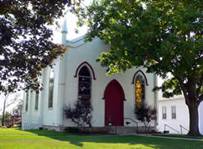
In 1845 construction began on a frame church. St. Luke’s opened for worship on 1 March 1846. There was no resident rector until 1874, up to that time services were provided by the rectory from Oakville. In 1945 a cairn was erected at St. Luke’s to commemorate its centennial. (Microfilmed Fonds at McMaster University reels 188, 284, 334-336 with some confirmation records in St. Jude’s Fonds)
Palermo Cemetery on Dundas Street West
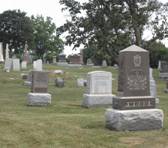
In 1818 a parcel of land in Lot 30 Concession 1 south was sold to Duncan McQueen, James Hopperd and James McBride by Charles Teetzel for the sum of 2 pounds and 10 shillings. The agreement said the land was “forever for the sole and proper use of a place to bury the dead for them and as many of the inhabitants of Trafalgar lying between the Twelve and Sixteen Mile Creeks as may think proper to join them: as also for a Meeting House and a school house should the same at any time be required”.
A log church was built in 1812 on the low where the cemetery now is. The Wesleyan Methodists were first mentioned in an article in the Christian Guardian in 1851. The two frame churches seem to have stood side by side in the cemetery lot until 1867. In this year, 17 years before the general union of Methodist churches, they untied and built the present church. At the time of the union, a small minority continued to worship in the small frame church. Eventually it was closed and used as a stable. – taken from a history by Rev. M.J. Aiken – 1962
Buildings not on the inventory but significant to Palermo
2496 Bronte Rd
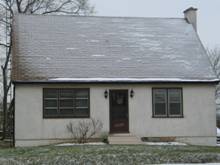
2467 Bronte Rd
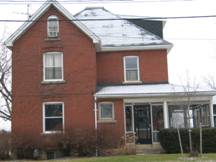
2477 Bronte Rd
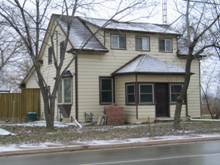
Anson’s Restaurant (Designated)
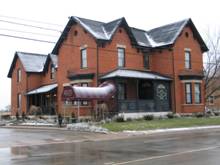
Bronte Rd
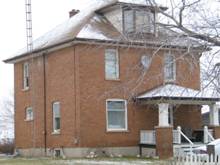
2480 Bronte Rd c.1890’s
